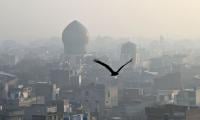KARACHI: Pakistan will need approximately $40 billion in funds to achieve the desirable level of greenhouse gas emissions during the next one and half decade, the Asian Development Bank (ADB) said in a recent report, pinpointing a strong institutional setup in the country to improve its access to global climate finance.
ADB said Pakistan is one of the countries that are most vulnerable to climate change effects, including catastrophic floods, droughts and cyclones.
“As described in its Nationally Determined Contribution to the Paris Agreement under the United Nations Framework Convention on Climate Change, Pakistan intends to reduce up to 20 percent of its 2030 projected greenhouse gas emissions, subject to availability of international grants to meet the cumulative abatement costs amounting to approximately $40 billion,” Manila-based lender said in ‘Climate change profile of Pakistan’.
The Bank said Pakistan is one of the countries in South Asia where warming is
expected to remain more than the global mean “and climate change will impact the glaciers’ melting rate and precipitation patterns, particularly affecting the timing and strength of monsoon rainfall.”
“Consequently, this will significantly impact the productivity and efficiency of water-dependent sectors such as agriculture and energy,” it added. ADB said the thermal resources-dependent energy sector is the biggest contributor of greenhouse gas emissions (GHG), accounting for nearly half of the total national GHG emissions inventory.
Hydropower resources, which supply around 30 percent of electricity, are expected to be affected by the recession of Himalayan glaciers that is the largest source of freshwater supply in the country, it added.
The Bank said hotter temperatures are likely to increase energy demand due to increased air conditioning requirements. Warmer air and water temperatures may decrease the efficiency of nuclear and thermal power plant generation.
The Asian Development Bank, however, recommended construction of additional water storage, diversification of energy mix including investment in renewable and small hydropower projects, improvement of weather forecasting and warning systems, retrofitting of critical energy infrastructure, and construction of dikes or sea walls.
The Bank said Pakistan lacks adaptation and mitigation strategies to combat climate change threats. The country launched ministry of climate change in 2013 despite it has signed 14 international environmental commitments between 1971 and 2001.
It said weak institutional setup in the country keeps its share in global climate change finance to minimal. It has only $15 million in disbursements of multilateral finance explicitly for climate change as of 2012.
Annual global climate finance flows amounted to approximately $331 billion in 2013, of which $34 billion flowed from developed to developing countries. The Bank said climatic changes are expected to reduce agricultural productivity, increase variability of water availability, raise coastal erosion and seawater incursion, and aggravate frequency of extreme climatic events.
It estimated that the rise in temperature between 0.5 to two centigrades would bring agriculture productivity down eight to 10 percent by 2040. “Addressing these risks requires the mainstreaming of climate change into national strategy and policy; and climate-smart investments in infrastructure, businesses and skills,” Akmal Siddiq, a director of agriculture, water, and natural resources division at ADB said in the report.
ADB said warming-driven higher evaporation rates may lead to growing demand of irrigation water and this situation is expected to bite yields of wheat and basmati rice – the two key cash crops for the agriculture-dependent economy.
The Bank advised the policymakers to develop or use crop varieties with greater heat and drought tolerance, modernise irrigation infrastructure, employ water-saving technologies, integrate watershed management, and increase reforestation of catchment areas.
ADB said climate change will also affect urban infrastructure and transport sector in Pakistan, which is the sixth most populous country in the world. “In economic terms, there are two types of impacts of extreme weather events on the transportation system,” it added.
“The first is the damage inflicted upon infrastructure, such as flood damage to
road, rail, and bridges. The second is the economic cost of interruptions in the
operation of the transportation systems, which prevent employees from going to work; shoppers from getting to stores; and goods from being delivered to factories, warehouses, and stores.”
A representational of a mine in Balochistan. —Reuters/File KARACHI: Bolan Mining Enterprise , a joint venture...
A Sindh Bank branch seen in this undated image.— Buzdy.com/file KARACHI: Sindh Bank organised a Haj balloting...
This representational image shows Gold bars. — AFP/FileKARACHI: Gold prices rose by Rs1,600 per tola on Wednesday in...
Dr. S Akbar Zaidi, Executive Director, IBA Karachi and Farrukh H. Sabzwari, Managing Director & CEO, Pakistan Stock...
Donald Trump displays his signature after signing the $1.5 trillion tax overhaul plan in the Oval Office of the White...
A visual representation of the digital cryptocurrency Bitcoin. — AFP/FileNEW YORK: Investors in the world’s...







